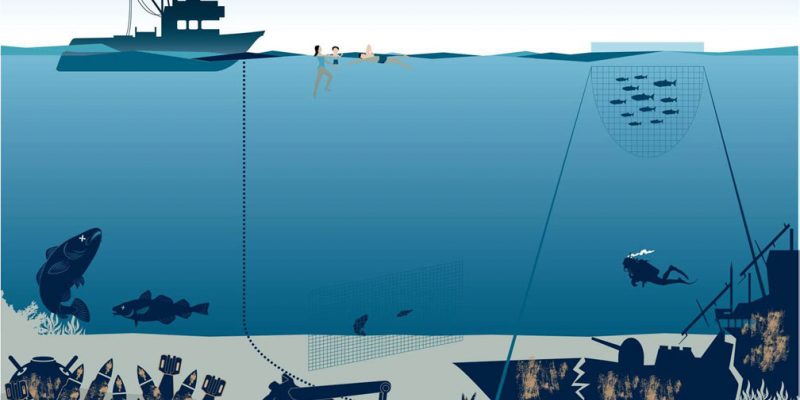Pollution from conventional ammunition
The metal shells of ammunition (e.g. bombs, mines and grenades) rust over time, releasing the pollutants they contain into the marine environment. The pollutants in conventional ammunition are so-called explosive-typical compounds (ETC) such as 2,4,6-trinitrotoluene (TNT) and other nitroaromatics, hexahydro-1,3,5-trinitro-1,3,5-triazine (RDX), octahydro-1,3,5,7-tetranitro-1,3,5,7-tetrazocine (HMX). TNT and its metabolites are nitroaromatics and as such toxic, carcinogenic and/or mutagenic.
Apart from the compounds typical for explosives, conventional ammunition also contains heavy metals such as mercury. Heavy metals also end up in the marine environment after the metal shells rust away.
Analytical detection of such chemicals in the marine environment is not easy, as they currently still occur in very low concentrations and reach higher concentrations only near the dumping areas and can accumulate in marine organisms such as mussels.
The German Environment Agency has therefore commissioned the Institute of Toxicology and Pharmacology for Natural Scientists at the University Medical Centre Schleswig-Holstein (Universitätsklinikum Schleswig-Holstein, UKSH) in Kiel to analyse various biological samples (such as mussels and fish, but also marine mammals) as well as sediment for different explosive-typical compounds and their metabolites. The data obtained on the spatial distribution and temporal development of ETC in marine organisms will be toxicologically assessed. The results of the study are expected to be published in early 2023.
Pollution from chemical munitions
Significantly more chemical munitions (5,000 tonnes) were dumped in the Baltic Sea than in the North Sea (approx. 90 tonnes in the Helgoland Loch).
Chemical warfare agents are chemical compounds used for military purposes that disrupt the physiological functions of the human organism to such an extent that the fighting ability of soldiers is impaired or even death is caused. They were used in the 1st World War; during World War II, they were only produced. The substances in question are: predominantly sulphur mustard (skin irritant), Tabun (nerve irritant), Phosgene (lung irritant), Chloracetophen (eye irritant) and Clark I, Clark II, Adamsite and Arsine Oil (nasal and throat irritants).
Böttcher et al., 2011 describe the dangers to the marine environment posed by these dumped warfare agents: Except for tabun, all aforementioned warfare agents are heavier than seawater or decompose in water. Thus, dumped warfare agents do neither tend to rise to the sea surface nor to be drifted. The reaction of the warfare agents with water through hydrolysis produces less toxic substances. Exceptions are tough-lost (mixture of S-lost and thickening agent) and arsenic-containing compounds. Tough-lost (and to a lesser extent normal S-lost) can also appear for a long time after release from ammunition containers in the form of more or less large, elastic chunks and can still develop its full effectiveness as a skin warfare agent if it reaches the sea surface, for example by getting caught in fishing nets, and comes into contact with the skin there. The arsenic-containing compounds Clark I, Clark II and Adamsite can, due to their persistence, remain in the marine environment for longer periods and, locally, in higher concentrations, especially in the sediment. However, they do not form lumps like Tough-lost.
Most of the accidents with warfare agents known so far were caused by Tough-Lost around the dumping area east of the Danish Baltic Sea island Bornholm, because lumps of Tough-Lost got caught in fishing nets.
Contamination by white phosphorus
White phosphorus was used as agent in certain incendiary munitions (e.g. phosphorus incendiary bombs). It is a modification of elemental phosphorus and ignites spontaneously with oxygen at 20 to 40 °C and burns at up to 1,300 °C.
To this day, chunks of white phosphorus that look like amber are washed up on German beaches, especially near Usedom, where about 1.2 tonnes entered the sea due to misdirected incendiary bombs (Böttcher et al., 2011). In these areas, warnings are posted to alert tourists to the dangers. Since these chunks are believed to be amber, accidents caused by beach findings of white phosphorus are more likely to occur on the beaches of the Baltic Sea than on the North Sea.
Salvage of ammunition
If munition waste poses a risk to shipping, it is, for the time being, defused and recovered by explosive ordnance disposal, and sent to the only German disposal facility, the Association for Disposal of Chemical Warfare and Military Waste (Gesellschaft zur Entsorgung von chemischen Kampfstoffen und Rüstungsaltlasten) in Munster, for destruction.
If defusing by divers is not possible, the ammunition is blown up. Since this does not completely destroy the pollutants, but rather releases them into the environment (Maser & Strehse, 2020), blasting should be avoided. In addition, blasting may induce a temporary or permanent threshold shift in marine mammals’ hearing ability.
In 2019, the Conference of the German Federal and State Ministers of Environment decided to advance the availability of data and information regarding the risk that is posed to the marine environment from dumped ammunition and, on this basis, to decide on the necessity and suitability of measures, including salvage and disposal, starting in the Baltic Sea.
It is currently being discussed that a floating mobile disposal facility should be built for the destruction of ammunition waste. The prototype of an unmanned, video-controlled collection device for ammunition designed in a project (ROBEMM) would have to be tested in the sea. The financing of all these measures still needs to be clarified.
 Click to enlarge
Click to enlarge
